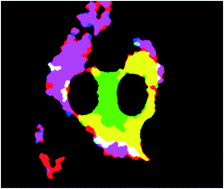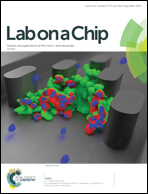A multiplexed microfluidic system for evaluation of dynamics of immune–tumor interactions
Abstract
Recapitulation of the tumor microenvironment is critical for probing mechanisms involved in cancer, and for evaluating the tumor-killing potential of chemotherapeutic agents, targeted therapies and immunotherapies. Microfluidic devices have emerged as valuable tools for both mechanistic studies and for preclinical evaluation of therapeutic agents, due to their ability to precisely control drug concentrations and gradients of oxygen and other species in a scalable and potentially high throughput manner. Most existing in vitro microfluidic cancer models are comprised of cultured cancer cells embedded in a physiologically relevant matrix, collocated with vascular-like structures. However, the recent emergence of immune checkpoint inhibitors (ICI) as a powerful therapeutic modality against many cancers has created a need for preclinical in vitro models that accommodate interactions between tumors and immune cells, particularly for assessment of unprocessed tumor fragments harvested directly from patient biopsies. Here we report on a microfluidic model, termed EVIDENT (ex vivo immuno-oncology dynamic environment for tumor biopsies), that accommodates up to 12 separate tumor biopsy fragments interacting with flowing tumor-infiltrating lymphocytes (TILs) in a dynamic microenvironment. Flow control is achieved with a single pump in a simple and scalable configuration, and the entire system is constructed using low-sorption materials, addressing two principal concerns with existing microfluidic cancer models. The system sustains tumor fragments for multiple days, and permits real-time, high-resolution imaging of the interaction between autologous TILs and tumor fragments, enabling mapping of TIL-mediated tumor killing and testing of various ICI treatments versus tumor response. Custom image analytic algorithms based on machine learning reported here provide automated and quantitative assessment of experimental results. Initial studies indicate that the system is capable of quantifying temporal levels of TIL infiltration and tumor death, and that the EVIDENT model mimics the known in vivo tumor response to anti-PD-1 ICI treatment of flowing TILs relative to isotype control treatments for syngeneic mouse MC38 tumors.

- This article is part of the themed collections: Immunotherapy, Lab on a Chip Recent HOT Articles and Organ-, body- and disease-on-a-chip systems


 Please wait while we load your content...
Please wait while we load your content...